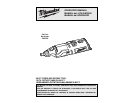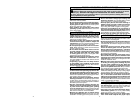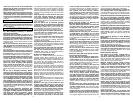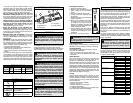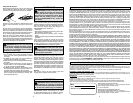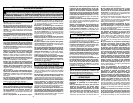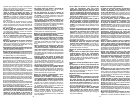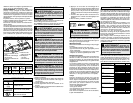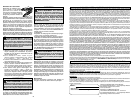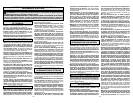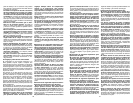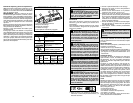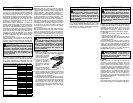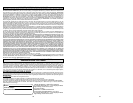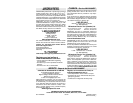
4
5
SPECIFIC SAFETY RULES
SERVICE
• Safety Warnings Common for Grinding, Sand-
ing, Wire Brushing, Polishing or Abrasive
Cutting-Off Operations:
• This power tool is intended to function as a
grinder, sander, wire brush, polisher or cut-off
tool. Read all safety warnings, instructions, il-
lustrations and specifi cations provided with
this power tool. Failure to follow all instructions
listed below may result in electric shock, fi re and/
or serious injury.
• Do not use accessories which are not specifi -
cally designed and recommended by the tool
manufacturer. Just because the accessory can
be attached to your power tool, it does not assure
safe operation.
• The rated speed of the accessory must be at
least equal to the maximum speed marked on
the power tool. Accessories running faster than
their RATED SPEED can break and fl y apart.
• The outside diameter and the thickness of your
accessory must be within the capacity rating
of your power tool. Incorrectly sized accesso-
ries cannot be adequately guarded or controlled.
• The arbour size of wheels, fl anges, backing
pads or any other accessory must properly
fi t the spindle of the power tool. Accessories
with arbour holes that do not match the mounting
hardware of the power tool will run out of balance,
vibrate excessively and may cause loss of con-
trol.
• Do not use a damaged accessory. Before
each use inspect the accessory such as abra-
sive wheels for chips and cracks, backing pad
for cracks, tear or excess wear, wire brush for
loose or cracked wires. If power tool or acces-
sory is dropped, inspect for damage or install
an undamaged accessory. After inspecting
and installing an accessory, position your-
self and bystanders away from the plane of
the rotating accessory and run the power tool
at maximum no-load speed for one minute.
Damaged accessories will normally break apart
during this test time.
• Wear personal protective equipment. De-
pending on application, use face shield, safe-
ty goggles or safety glasses. As appropriate,
wear dust mask, hearing protectors, gloves
and workshop apron capable of stopping
small abrasive or workpiece fragments. The
eye protection must be capable of stopping fl ying
debris generated by various operations. The dust
mask or respirator must be capable of fi ltrating
particles generated by your operation. Prolonged
exposure to high intensity noise may cause hear-
ing loss.
• Keep bystanders a safe distance away from
work area. Anyone entering the work area
must wear personal protective equipment.
Fragments of workpiece or of a broken accessory
may fl y away and cause injury beyond immediate
area of operation.
• Hold the power tool by insulated gripping
surfaces only, when performing an operation
where the cutting accessory may contact hid-
den wiring. Contact with a “live” wire will also
make exposed metal parts of the power tool “live”
and could give the operator an electric shock.
• Never lay the power tool down until the acces-
sory has come to a complete stop. The spin-
ning accessory may grab the surface and pull the
power tool out of your control.
• Do not run the power tool while carrying it at
your side. Accidental contact with the spinning
accessory could snag your clothing, pulling the
accessory into your body.
• Regularly clean the power tool’s air vents. The
motor’s fan will draw the dust inside the housing
and excessive accumulation of powdered metal
may cause electrical hazards.
• Do not operate the power tool near fl ammable
materials. Sparks could ignite these materials.
• Do not use accessories that require liquid
coolants. Using water or other liquid coolants
may result in electrocution or shock.
Kickback and Related Warnings
Kickback is a sudden reaction to a pinched or
snagged rotating wheel, backing pad, brush or
any other accessory. Pinching or snagging causes
rapid stalling of the rotating accessory which in
turn causes the uncontrolled power tool to be
forced in the direction opposite of the accessory’s
rotation at the point of the binding.
For example, if an abrasive wheel is snagged or
pinched by the workpiece, the edge of the wheel
that is entering into the pinch point can dig into
the surface of the material causing the wheel to
climb out or kick out. The wheel may either jump
toward or away from the operator, depending on
direction of the wheel’s movement at the point of
pinching. Abrasive wheels may also break under
these conditions.
Kickback is the result of power tool misuse and/or
incorrect operating procedures or conditions and
can be avoided by taking proper precautions as
given below.
• Maintain a fi rm grip on the power tool and
position your body and arm to allow you to
resist kickback forces. Always use auxiliary
handle, if provided, for maximum control over
kickback or torque reaction during start-up.
The operator can control torque reactions or kick-
back forces, if proper precautions are taken.
• Never place your hand near the rotating acces-
sory. Accessory may kickback over your hand.
•
Do not position your body in the area where
coins, keys, nails, screws, or other small metal
objects that can make a connection from one
terminal to another. Shorting the battery terminals
together may cause burns or a fi re.
• Under abusive conditions, liquid may be eject-
ed from the battery; avoid contact. If contact
accidentally occurs, fl ush with water. If liquid
contacts eyes, additionally seek medical help.
Liquid ejected from the battery may cause irritation
or burns.
• Have your power tool serviced by a qualifi ed
repair person using only identical replacement
parts. This will ensure that the safety of the power
tool is maintained.
power tool will move if kickback occurs. Kick-
back will propel the tool in direction opposite to
the wheel’s movement at the point of snagging.
• Use special care when working corners,
sharp edges etc. Avoid bouncing and snag-
ging the accessory. Corners, sharp edges or
bouncing have a tendency to snag the rotating
accessory and cause loss of control or kickback.
• Do not attach a saw chain woodcarving blade
or toothed saw blade. Such blades create fre-
quent kickback and loss of control.
Safety Warnings Specifi c for Grinding and
Abrasive Cutting-Off Operations:
• Use only wheel types that are recommended
for your power tool and the specifi c guard
designed for the selected wheel. Wheels for
which the power tool was not designed cannot be
adequately guarded and are unsafe.
• Wheels must be used only for recommend-
ed applications. For example: do not grind
with the side of cut-off wheel. Abrasive cut-off
wheels are intended for peripheral grinding, side
forces applied to these wheels may cause them
to shatter.
• Always use undamaged wheel fl anges that
are of correct size and shape for your selected
wheel. Proper wheel fl anges support the wheel
thus reducing the possibility of wheel breakage.
Flanges for cut-off wheels may be different from
grinding wheel fl anges.
• Do not use worn down wheels from larger
power tools. Wheel intended for larger power
tool is not suitable for the higher speed of a small-
er tool and may burst.
Additional Safety Warnings Specifi c for Abra-
sive Cutting-Off Operations:
• Do not “jam” the cut-off wheel or apply exces-
sive pressure. Do not attempt to make an ex-
cessive depth of cut. Overstressing the wheel
increases the loading and susceptibility to twist-
ing or binding of the wheel in the cut and the pos-
sibility of kickback or wheel breakage.
• Do not position your body in line with and
behind the rotating wheel. When the wheel, at
the point of operation, is moving away from your
body, the possible kickback may propel the spin-
ning wheel and the power tool directly at you.
• When wheel is binding or when interrupting
a cut for any reason, switch off the power
tool and hold the power tool motionless until
the wheel comes to a complete stop. Never
attempt to remove the cut-off wheel from the
cut while the wheel is in motion otherwise
kickback may occur. Investigate and take cor-
rective action to eliminate the cause of wheel
binding.
• Do not restart the cutting operation in the
workpiece. Let the wheel reach full speed and
carefully reenter the cut. The wheel may bind,
walk up or kickback if the power tool is restarted
in the workpiece.
• Support panels or any oversized workpiece to
minimize the risk of wheel pinching and kick-
back. Large workpieces tend to sag under their
own weight. Supports must be placed under the
workpiece near the line of cut and near the edge
of the workpiece on both sides of the wheel.
• Use extra caution when making a “pocket cut”
into existing walls or other blind areas. The
protruding wheel may cut gas or water pipes, elec-
trical wiring or objects that can cause kickback.
Safety Warnings Specifi c for Sanding Operations:
• Do not use excessively oversized sanding
disc paper. Follow manufacturers recommen-
dations, when selecting sanding paper. Larger
sanding paper extending beyond the sanding
pad presents a laceration hazard and may cause
snagging, tearing of the disc or kickback.
Sa
fety Warnings Specifi c for Polishing Operations:
• Do not allow any loose portion of the polish-
ing bonnet or its attachment strings to spin
freely. Tuck away or trim any loose attach-
ment strings. Loose and spinning attachment
strings can entangle your fi ngers or snag on the
workpiece.
Safety Warnings Specifi c for Wire Brushing
Operations:
• Be aware that wire bristles are thrown by the
brush even during ordinary operation. Do not
overstress the wires by applying excessive
load to the brush. The wire bristles can easily
penetrate light clothing and/or skin.
• If the use of a guard is recommended for wire
brushing, do not allow any interference of the
wire wheel or brush with the guard. Wire wheel
or brush may expand in diameter due to work
load and centrifugal forces.
Additional Safety Warnings
• The arbour size of wheels, sanding drum or
any other accessory must properly fi t the
spindle or collet of the power tool. Accessories
that do not match the mounting hardware of the
power tool will run out of balance, vibrate exces-
sively and may cause loss of control.
• Mandrel mounted wheels, sanding drums,
cutters or other accessories must be fully
inserted into the collet or chuck. The “over-
hang” or the length of the mandrel from the
wheel to the collet must be minimal. If the
mandrel is insuffi ciently held and/or the overhang
of the wheel is too long, the mounted wheel may
become loose and ejected at high velocity.
• After changing the bits or making any adjust-
ments, make sure the collet nut, chuck or any
other adjustment devices are securely tight-
ened. Loose adjustment devices can unexpect-
edly shift, causing loss of control, loose rotating
components will be violently thrown.
• Always feed the bit into the material in the
same direction as the cutting edge is exiting
from the material (which is the same direction
as the chips are thrown). Feeding the tool in the
wrong direction causes the cutting edge of the bit
to climb out of the work and pull the tool in the
direction of this feed.
• When using steel saws, cut-off wheels, high
speed cutters or tungsten carbide cutters, al-
ways have the work securely clamped. These
wheels will grab if they become slightly canted



